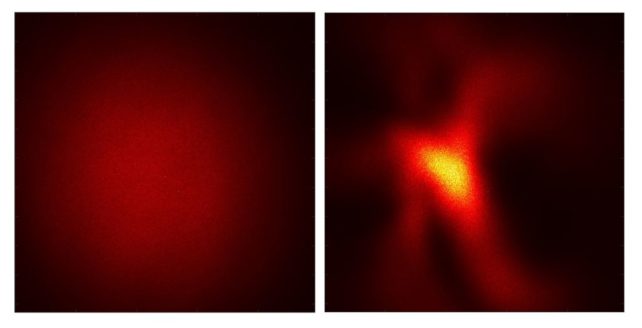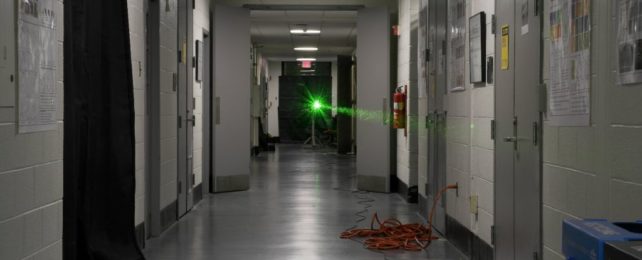Physicists have just set a new record confining a self-focused laser pulse to a cage of air, down the length of a 45 meter-long (148 foot-long) university corridor.
With previous results falling well short of a meter, this newest experiment led by physicist Howard Milchberg of the University of Maryland (UMD) breaks new ground for confining light to channels known as air waveguides.
A paper describing the research has been accepted into the journal Physical Review X, and can in the meantime be found on the preprint server arXiv . The results could inspire new ways to achieve long-range laser-based communications or even advanced laser-based weapons technology.
"If we had a longer hallway, our results show that we could have adjusted the laser for a longer waveguide," says UMD physicist Andrew Tartaro.
"But we got our guide right for the hallway we have."
Lasers can be useful for a range of applications, but the coherent rays of neatly-arranged light need to be corralled and focused in some way. Left to its own devices, a laser will scatter, losing power and effectiveness.
One such focusing technique is the waveguide, and it's exactly what it sounds like: it guides electromagnetic waves down a specific path, preventing them from scattering.
Optical fiber is one example. This consists of a glass tube along which electromagnetic waves are directed. Because the cladding around the outside of the tube has a lower refractive index than the center of the tube, light that tries to scatter instead bends back into the tube, maintaining the beam along its length.
In 2014, Milchberg and his colleagues successfully demonstrated what they called an air waveguide. Rather than using a physical construct such as a tube, they used laser pulses to corral their laser light. They found that pulsed laser creates a plasma that heats the air in its wake, leaving behind a path of lower-density air. It's like lightning and thunder in miniature: the expanding lower-density air creates a sound like a tiny thunderclap following the laser, creating what's known as a filament.
The lower density air has a lower refractive index than the air around it – like the cladding around an optical fiber tube. So firing these filaments in a specific configuration that "cages" a laser beam in their center effectively creates a waveguide out of the air.
The initial experiments described in 2014 created an air waveguide of about 70 centimeters (2.3 feet) long, using four filaments. To scale the experiment up, they needed more filaments – and a much longer tunnel down which to shine their lights, preferably without having to move their heavy equipment. Hence, a long corridor at UMD's Energy Research Facility, altered to allow the safe propagation of lasers beamed through a hole in the lab wall.
Corridor entry points were blocked, shiny surfaces covered, laser-absorbing curtains deployed.
"It was a really unique experience," says UMD electrical engineer Andrew Goffin, the first author on the team's paper.
"There's a lot of work that goes into shooting lasers outside the lab that you don't have to deal with when you're in the lab – like putting up curtains for eye safety. It was definitely tiring."

Finally, the team was able to create a waveguide capable of traversing a 45 meter corridor – accompanied by crackling, popping noises, the tiny thunderclaps created by their laser filament "lightning". At the end of the air waveguide, the laser pulse in the center had retained about 20 percent of the light that would have been otherwise lost without a waveguide.
Back in the lab, the team also studied a shorter, 8-meter air waveguide, to take measurements of the processes that occurred in the hallway, where they didn't have the equipment to do so. These shorter tests were able to retain 60 percent of the light that would have been lost. The tiny thunderclaps were also useful: the more energetic the waveguide, the louder the pop.
Their experiments revealed that the waveguide is extremely fleeting, lasting just hundredths of a second. To guide something that's traveling the speed of light, however, that time is ample.
The research suggests where improvements can be made; for example, higher guiding efficiency and length should result in even less light lost. The team also wants to try different colors of laser light, and a faster filament pulse rate, to see if they can guide a continuous laser beam.
"Reaching the 50-meter scale for air waveguides literally blazes the path for even longer waveguides and many applications," Milchberg says.
"Based on new lasers we are soon to get, we have the recipe to extend our guides to one kilometer and beyond."
The research has been accepted in Physical Review X, and is available on arXiv.
